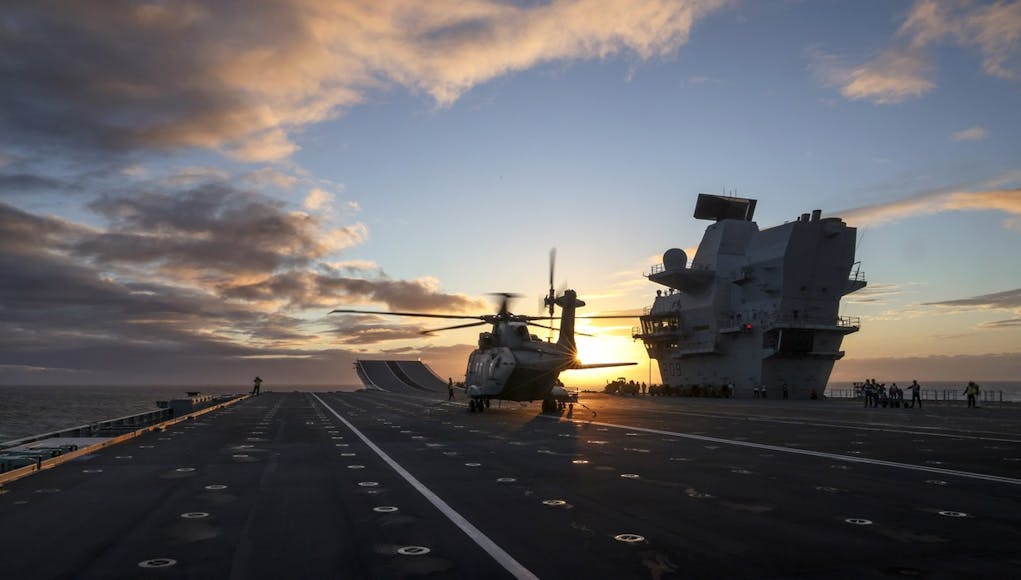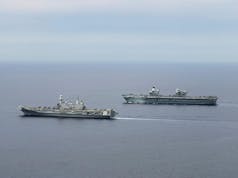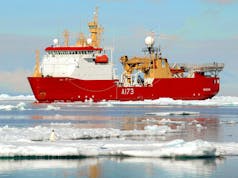The Royal Navy say that the flight deck of HMS Prince of Wales is buzzing with air power again – as the force generates a second 65,000-tonne aircraft carrier ready for front-line operations.
Honouring 80 years since the sinking of HMS Hood with a short service.
The last @HMSPWLS was in company with Hood and sort battle with the German ships, Bismarck & Prinz Eugen.
Hood was sunk with the loss of 1415 men. Only 3 survived.#WeWillRememberThem #HMSHood pic.twitter.com/9m0MDDeTxE
— HMS Prince of Wales (@HMSPWLS) May 24, 2021
According to a Royal Navy news release:
“The Portsmouth-based warship has spent much of her first fortnight back at sea in the relatively sheltered waters of Lyme Bay conducting aviation trials with the RAF and Commando Helicopter Force.
The ship’s company has changed substantially since she last sailed in the spring of 2020 – and since her flight deck last welcomed helicopters, so it’s been a mix of brushing up on old skills and new experiences for a good number of sailors.
Those on the upper deck were treated to the impressive sight of a unique RAF Chinook, proudly sporting a Union Jack tail to celebrate its 40th anniversary in UK service, touching down. The Boeing-built helicopter entered service with the air force in November 1980 and has seen action in every major conflict involving the nation’s armed forces since.”
After the much-publicised first encounter at sea with her big sister HMS Queen Elizabeth, regular training resumed with Merlin helicopters of 824 Naval Air Squadron making use of the carrier to practise refuelling skills.
You can read more here.














sort battle?! sought?
Short battle maybe, it was left alone after the sinking of Hood and suffered various gunnery malfunctions so had to withdraw (I’m sure I read the book when I was kid)
PoW hit the Bismarck 3 times before withdrawing.
Hi Folks, Yes – and one of those three 14 inch shells from PoW played a big part in the German battleship’s eventual demise.
A strike near the bow caused seawater to contaminate up to 2, 000 tonnes of Bismarck’s fuel oil, restricting the German Admiral’s operational flexibility – and causing him to cut and run for Brest. The rest is history ………
Obviously a typo on their part.
Absolutely, just trying to work out what they were trying to say!
sought, presumably.
I must confess I had not realised it was 80 years….
In a few days we can remember the Bismark.
It is worth remembering that it only also took a couple, may be 1, shell to disable the Bismarck. After that it was reduced to a collender. I think 1 shell wiped out all on the conning tower and communations and ranging and another one turret.
For all the effort to build these battleships … they were vulnerable.
It wasn’t a bomb that disabled Bismarck, it was a torpedo fired by a Swordfish biplane. It hit her at the stern, jammed the rudder and sent her round in circles – thence an easy target.
One of the first shells hit Bismark in such a way that it lost fuel and shipped water to the extent that the Germans aborted the mission and the ship headed to Brest. It was then completely disabled by a torpedo hit.
He’s talking about one of HMS Rodney’s 16 inch shells that knocked out her fire controls, nothing to do with bombs. The Swordfish just stopped her from escaping, dientvdisable her as a combat platform.
Agreed – sorry my mistake, no bombing involved – I meant to have said shells. She would have escaped to Brest if her torpedoed jammed rudder hadn’t stopped her.
Yes, Dern – one can argue it was the 16 inch shells from Rodney that pulverised Bismarck on 27 May, and the veteran battleship deserves most of the kudos for sinking Lutjen’s flagship that day – not the newer KGV.
My point being that effectively 1 shell scuppered the Bismarck in the same way a shell did for Hood. Once even battleships start to get hit they are exposed to being vulnerable.
The Rodney was slow and normally the Bismarck could have escaped of course. So it is fair to mention the torpedo… but that was not my main point.
HI Trevor, I understand your argument, although this wouldn’t be UKDJ without a counter-point! 😊
I don’t feel one shell did “scupper Bismarck in the same way as a shell did for Hood”. A single shell caused the catastrophic destruction of the British battle-cruiser; but in Bismarck’s case, despite the main fire-director being destroyed, and forward turrets damaged, the German battleship continued the fight from back-up positions and the aft turrets. The RN later claimed up to 400 shell-hits before Bismarck succumbed in a 90 minute show-down.
We all know the Bismarck episode highlighted the vulnerability of capital ships to air-dropped torpedoes, even the tiny 18-inch ones used by the British.
I think the main point the Kriegsmarine drew was that an unsupported battleship sortie deep into the North Atlantic (even by 1941, fast becoming an Anglo-American pond) was reckless in the extreme, indeed foolhardy, and the German navy never attempted anything similar again.
Didn’t hood also take multiple shells hits before one penetrated her magazines?
At the end of the day it’s impossible to fully armour a ship against battleship caliber weapons, just like its impossible to fully armour a human in plate. You have to leave some aspects exposed, and it’s really about survivability until you can put the enemy’s ship down, rather than being bullet (shell?) Proof.
That doesn’t mean that battleships where vulnerable either though, often it required another battleship (worth noting that multiple torpedo hits by the FAA on Bismark did absolutely nothing other than get eaten by her anti torpedo defences, so it’s doubtful that without Rodney and KGV the RN could’ve sunk her) or overwhelming force of numbers to put one down.
Worth also noting that the Kriegsmarine did make convoy raids by it’s battleships after Bismark, but on the Murmansk route, rather than the Atlantic.
Hi Dern, Must confess I had to recheck – but Hood blew-up only 8 minutes after her first salvo. And although hit twice, on the boat-deck and spotting-top, with some loss of life, at the moment of the catastrophic conflagration – was fully operational and tearing towards the enemy.
I agree with many of your other comments, evidence suggests a modern WW2 battleship (unlike Hood) was very hard to sink. Bismarck was a powerful, resilient unit – but its strength was whittled down through a succession of blows over 72 hours (24 – 27 May). That included a 14 inch shell from PoW which caused seawater to contaminate up to 2, 000 tonnes of Bismarck’s fuel oil – and limited Lutjens freedom of action, it included the famous Swordfish strike on the rudder – and finally it included those pulverising 16 inch shells from Rodney. The stress of continual high intensity operations also degraded the effectiveness of the crew – and the ship’s leadership.
If Bismarck had been accompanied by a task-group, mutual support may have mitigated the impact of those blows, but she was left to her own devices – and ultimately succumbed to the British onslaught.
I agree – capital ships of the Kriegsmarine did make convoy raids from Norwegian fjords (and Scharnhorst was lost during one on 26 December 1943). But these were short duration sorties over 72 hours, conducted with the support of the Luftwaffe, U-Boats – and other surface units.
Instead, Bismarck was sunk on an intended two months commerce raiding sortie deep into the Atlantic – but in a disastrous failure of German naval planning, committed to operations with insufficient support.
Was touring the top of Scotland a while back, part of which included Loch Eriboll , The last stop for the Mighty Hood before the battle…… There are stones spelling her name on the Hill together with a few others including Warspite from memory, either way, RIP Mates.
I did a 6 month tour of Ascension island and on the hill behind George town is a pair of 5.5 inch guns from HMS Hood which were sent down there after its 1935 refit.
http://www.hmshood.com/hoodtoday/ascension.htm
can be easily seen on google maps
There’s a good chance Prince of Wales could end up been an helicopter platform ,useful at times but do hope she gets her own F35s as this what she was build for.✈ 🚁
She will, one carrier will always be available while the other is in refit so she’ll get her chance. It makes sense to utilise the “spare” as a helicopter carrier if needed and available or in an emergency situation.
There has never been any intention or possibility to field both carriers with their own air wings, it would need far more aircraft than we can afford.
The F-35s were ordered for the RAF to replace (a) 4 squadrons of Tornados in the interdiction/strike role and (b) 2 squadrons of AV-8B Harriers doing both ground support for the army and fighter/strike fighter/recon for the Navy.. So the breakdown for the 138 F-35s would be; 90 RAF interdiction/strike, 24 RAF ground support, 24 FAA carrier squadron.
Halve these figures and you get the front line squadron strength, so 12 for the RN.
There is a popular misbelief that the F-35s are or should be for the RN carriers. They are not, they were ordered to replace the gaping hole in our air capability left by the early – some would say premature – withdrawl of Tornado FGR4.
At £100m a pop for the B version, including the expensive Block 4 upgrade, it is very unlikely that more than 60 will be procured, so 30 front line between army support and FAA. Thereafter the RAF will almost certainly opt for the A version, due its longer range, larger payload and the fact that it is £20m cheaper than the B.
Basically, we have built large carriers that we cannot afford the aircraft for. on the current budget. When the carriers were ordered, the then,-govermment was spending 2.6% of GNP on defence, excluding pensions.
My recollection is you can also throw the replacement of Jaguar into the RAF mix as well although once they were retired that part of the replacement formula was dropped from press releases etc. Seem to the recall the last of the Jaguar squadrons were retired a couple of years after the F35 was selected but when the selection process commenced (late 90s) there were still about 4 operational squadrons.
There were if I remember correctly 4 squadrons of Jaguars before the fun started. Basically, we reduced something like 17 squadrons (Tornado, Jaguar, AV-8B, Sea Harrier) to 6, these to be replaced by 6 F-35 squadrons as soon as they came off the production line.
A decade on, we still don’t have one F-35 squadron at full strength!
Other countries seem more nimble and organised, the Germans whistled up F-18s and more Typhoons to cover the withdrawal of their Tornados.
Alas, our budget is so permanently stretched, trying to accommodate £3bn carriers and umpty £1bn plus warships and subs for the RN, there is no slack for anything else. Net result, out of the 5 big Western European nations, we are about last for deployable army brigades and RAF fast jet combat aircraft.
Oh, the joys of having a carrier and fantasing about ruling the waves again!
You’re a brave man, Cripes, praising the Germans on this forum!
😃
I agree the reduction in British combat jet strength has been shocking, 1991 Gulf War – 32 squadrons (including 800/801 FAA), 2021 – 8 squadrons (7 Typhoon, one F-35B).
A cut of 75%!
Even with the superlative performance of Typhoon, and the greater use of Precision Guided Weapons, there seems a shortfall in British air-power.
But we are an island, and I do think the UK should prioritise spending for the Royal Navy and Royal Air Force – if necessary, perhaps over the requirements of the Army.
We may be an island, but that is no guarantee of our security. A couple of River 1s and a carrier group could not defend the UK for a day in wartime. History reminds us how the fleet had to hide in the Wasb, much to Churchill’s chagrin, when the German Sea Lion invasion was imminent – they would have been sunk by enermy airpower in a morning.
The fact that no European country could stand alone against a peer invasion is why we have NATO. Collectively, our armies halt the aggressor while the air forces win air superiority and switch to interdiction and ground support.
The role of the navy is tertiary, at most it may engage some hostile submarines and maybe, in a longer war, provide some convoy escorts. But Russia’s surface fleet does not pose much of a challenge.
So strategically, the order of importance must logically be;
1. Air power, to control the battlespace
2. Army, to stop or at least slow enemy advance
3. Navy, at least in its ASW role.
It will be fatal if NATO members start retreating nto narrow, isolationist, nationalist stances (or swan off into global Britain type fantasies), it really is one for all and all for one if the NATO 30 are to survive and prosper.
Hi Cripes, I’m not into all that Global Britain tosh either – nor notions of British exceptionalism.
But in the context of NATO, I would argue that Britain’s primary role is to protect the reinforcement routes from North America to Europe – both on the seas (including under the Atlantic), and in the skies. There are plenty of continental powers like Germany and Poland to supply NATO with the bulk of its ground forces.
In that same context, the two greatest victories that Britain achieved in WW2 were the Battle of the Atlantic and the Battle of Britain. Both defensive battles ….
On the subject of Operation Sealion 1940, I feel it’s a Churchillian myth when some suggest only RAF Fighter Command stood between Britain and invasion. The Royal Navy would certainly have aggressively contested a Nazi cross-channel attempt. Many historians believe even a few flotillas of destroyers arriving at dawn off the south-coast would easily have destroyed the somewhat heath-robinson assembly of German invasion barges.